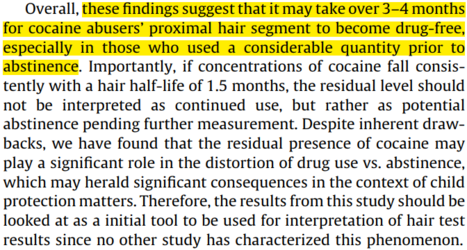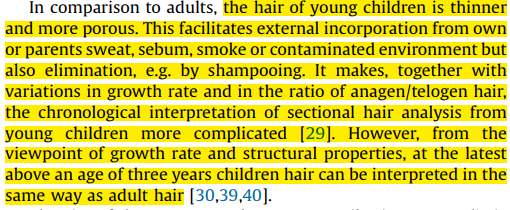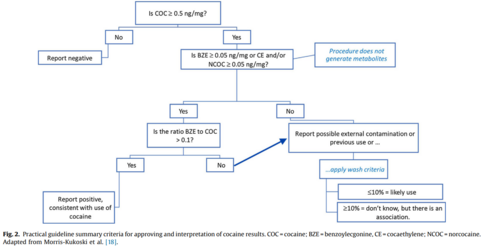Some Q&A about the cocaine found in Rekieta's 9-year-old child’s hair - an autistic analysis
#1. How long does cocaine stay in one's hair?
One of the first questions I've seen some people asking about was how long cocaine could be detected in someone's hair. I've seen that people already responded to that one, but I thought it was nice to give an answer based on the published literature.
One study about the pharmacokinetics of the disappearance of cocaine from hair after discontinuation of drug use found that it could take
about 3-4 months for cocaine abusers' proximal hair to be drug-free. This finding was supported by previously published information in the literature. It's important to note that this finding can vary somewhat with the half-life of your own hair.
 Garcia-Bournissen F, Moller M, Nesterenko M, Karaskov T, Koren G. Pharmacokinetics of disappearance of cocaine from hair after discontinuation of drug use [published correction appears in Forensic Sci Int. 2015 Dec;257:83] [published correction appears in Forensic Sci Int. 2015 Dec;257:83. doi: 10.1016/j.forsciint.2015.08.001]. Forensic Sci Int. 2009;189(1-3):24-27.
Garcia-Bournissen F, Moller M, Nesterenko M, Karaskov T, Koren G. Pharmacokinetics of disappearance of cocaine from hair after discontinuation of drug use [published correction appears in Forensic Sci Int. 2015 Dec;257:83] [published correction appears in Forensic Sci Int. 2015 Dec;257:83. doi: 10.1016/j.forsciint.2015.08.001]. Forensic Sci Int. 2009;189(1-3):24-27.
#2. Could we extrapolate the data of the cutoff points from adults to children?
It's important to note that children's hair is different from adults' hair. They differ from adult terminal hair in structure as well as in growth properties. However, considering Rekieta's case, this difference could be ignored, as
the hair from children > 3 years can be interpreted in the same way as an adult's hair.
 Pragst F, Krumbiegel F, Thurmann D, et al. Hair analysis of more than 140 families with drug consuming parents. Comparison between hair results from adults and their children. Forensic Sci Int. 2019;297:161-170. doi:10.1016/j.forsciint.2019.01.039
Pragst F, Krumbiegel F, Thurmann D, et al. Hair analysis of more than 140 families with drug consuming parents. Comparison between hair results from adults and their children. Forensic Sci Int. 2019;297:161-170. doi:10.1016/j.forsciint.2019.01.039
#3. Was that ACTIVE use or PASSIVE exposure?
That is a more difficult question to answer. Generally, from what I've found, the differentiation of cocaine usage vs. external contamination is based on levels of cocaine > 0.5 ng/mg + its metabolite above a cutoff value. Also, the washout data from the analysis process can be used for this interpretation. We don't have this data yet, so I don't think we can reliably differentiate contamination from active use.

 Tsanaclis L, Andraus M, Wicks J. Hair analysis when external contamination is in question: A review of practical approach for the interpretation of results. Forensic Sci Int. 2018;285:105-110. doi:10.1016/j.forsciint.2018.01.028
Tsanaclis L, Andraus M, Wicks J. Hair analysis when external contamination is in question: A review of practical approach for the interpretation of results. Forensic Sci Int. 2018;285:105-110. doi:10.1016/j.forsciint.2018.01.028
But one thing to consider is that the levels of cocaine found in the child's hair were reported to be ABOVE 5,000 pg/mg (> 10 times the cutoff value).

So EVEN if it was a finding of external exposure, how can you guarantee that this level of contamination wouldn't implicate that the child ALSO ingested it from other contaminated sources?
# Disclaimer - I have no power level within this topic. I just asked some questions and looked at the literature. Someone with more experience and knowledge within this area probably could raise other answers/questions.
Edit: grammar and clarity.
General discussion and Q&A about the PDF and the tests are best suited for the split thread. All of these questions and opinions already exist here.
Null has asked for limiting the discussion about these tests to the other thread (above). Sorry about posting it here, I forgot about the other thread.






